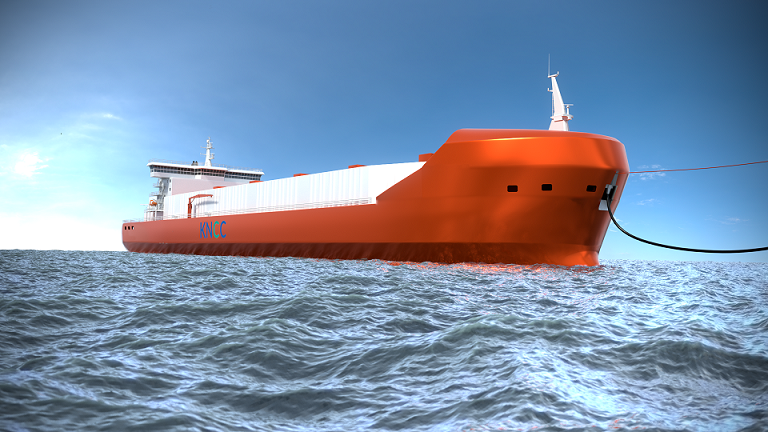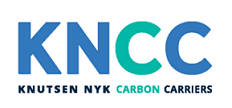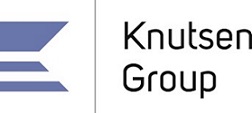Jan. 18, 2022
NYK and Knutsen Group Establish New Company for Liquefied CO2 Transportation and Storage Business
Contributing to the Realization of a Carbon-Neutral Society
NYK
Knutsen Group
NYK and the Knutsen Group of Norway have established a joint venture company for the commercial development of a liquefied CO2 marine transportation and storage business worldwide using the Knutsen developed technology PCO2® which allows transport of liquified CO2 at ambient temperatures. NYK and the Knutsen Group, will each hold 50% stake in the new company, which has been named Knutsen NYK Carbon Carriers AS (KNCC)*1. KNCC will also build and operate low/mid pressure vessels based on other technologies.
Carbon capture, utilization and storage (CCUS) *2 is an effective and necessary concept for realizing a carbon-neutral society. In this value chain, liquefied CO2 carriers play an essential role in transporting liquefied CO2 to the sites where it is stored and/or utilized. The demand for liquefied CO2 carriers is expected to grow rapidly going forward.

Image of liquefied CO2 carrier with bow loading system*3
The Knutsen Group and NYK have an innovative approach towards using and further developing new technology to meet a carbon neutral future. Being part of the same group as the world leading operator of Shuttle tankers through Knutsen NYK Offshore Tankers (KNOT), KNCC will provide customers with a unique competence for advanced transport including liquefied CO2 loading and offloading onshore and offshore. Through KNCC we will combine our extensive knowledge of ship operation and management to achieve the early realization of not only small and medium-sized vessels but also large liquefied CO2 vessel operations. The establishment of this joint venture will be an important foothold for participation in the CCUS value chain.
Svein Steimler, president and CEO of NYK Group Europe Ltd. and Trygve Seglem, owner and president of the Knutsen Group, will be the chair and vice-chair of the Board of Directors of KNCC. Anders Lepsøe has been appointed chief executive officer of the company. He has a broad international business background with extensive experience from the oil & gas-, financing-, and shipping industries.
Svein Steimler commented as follows: “Establishing KNCC enables NYK to offer marine transportation of liquefied CO2 which is an important milestone for reaching the targets set out in the Paris Agreement, and in line with NYK’s strategy and green business plan”.
Trygve Seglem commented as follows: “We are pleased to have developed a solution that is key to reach the ambitious climate goals. Combining the PCO2® technology with our first-class competence and experience within offshore operations enables us to offer a safe and regular marine transportation of liquefied CO2 to existing and new customers”.
For further information about Knutsen NYK Carbon Carriers AS and contact details please visit the website: http://www.kn-cc.com
Overview of each company
<KNCC>
Head Office: Haugesund, Norway
Business: Marketing and business development of liquefied CO2 transportation and storage
Investment Ratio: NYK 50%, Knutsen Group 50%
CEO: Anders Lepsøe
Website: http://www.kn-cc.com

<NYK>
Head Office: Tokyo, Japan
President and CEO: Hitoshi Nagasawa
Website: https://www.nyk.com/english/

<Knutsen Group>
Head Office: Haugesund, Norway
CEO: Trygve Seglem
Website: https://knutsenoas.com/https://knutsenoas.com/

*1 At this stage, KNCC is set up only for preparatory purposes and will be subject to any required approvals from relevant regulatory authorities in due course.
*2 Image of Carbon Capture, Utilization and Storage (CCUS) value chain:
CCUS refers to “carbon capture, utilization and storage” and is a process that captures CO2 released from thermal power plants, factories, etc. and either uses it in production processes for crops, chemicals, construction materials, etc. or stores it in a stable underground geological formation.

*3 Bow loading system
A system to carry out cargo operations from the bow of a tanker for on- and offshore operations. Such a system also allows cargo hoses to be connected or disconnected from offloading units easier than usual so that the tanker may evacuate quickly in case of an emergency.
The news on this website is as of the date announced and may change without notice.